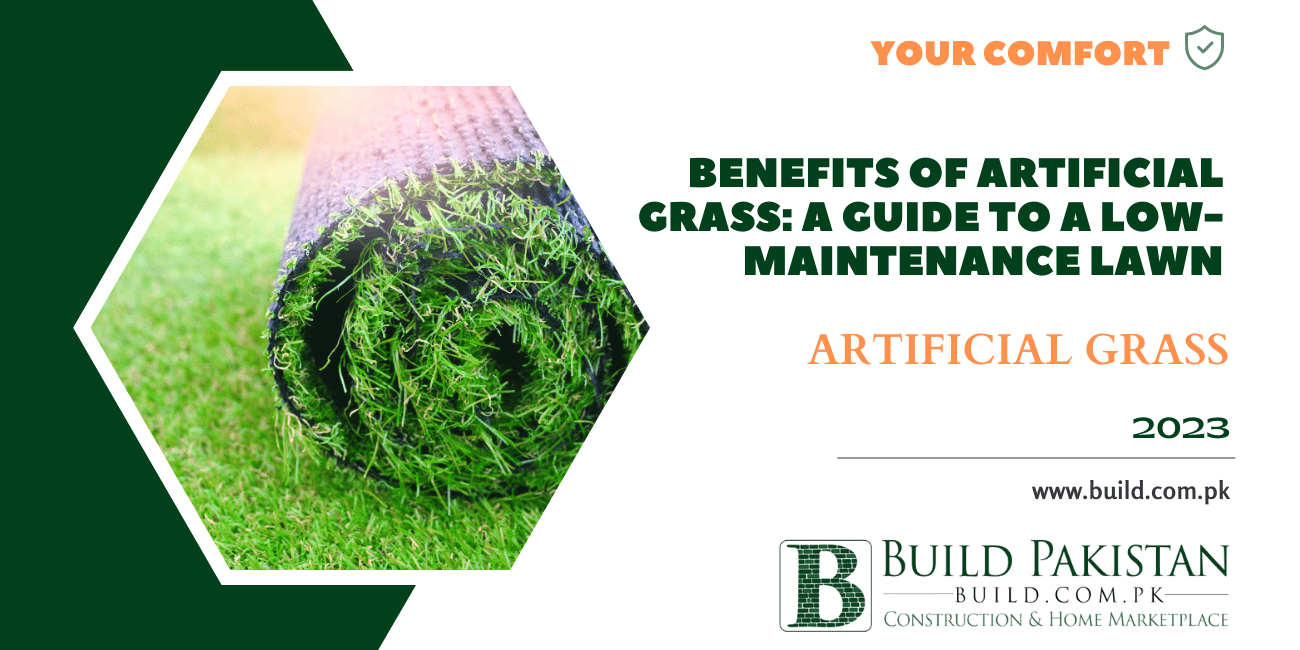Benefits of Artificial Grass: A Guide to a Low-Maintenance Lawn

Introduction:
Artificial grass, also known as synthetic turf, is a popular
alternative to natural grass for sports fields, residential lawns, and
commercial landscaping. It is a type of grass made from synthetic fibers that
mimic the look and feel of natural grass. The use of artificial grass has
increased significantly over the years due to its many benefits.
Types of Artificial Grass
There are two main types of artificial grass: infill and
non-infill.
- Infill artificial grass is filled with a mixture of sand and rubber particles to provide better cushioning and stability.
- Non-infill artificial grass does not require any filling, as
the fibers are made to stand up on their own.

Benefits of Artificial Grass
Low Maintenance:
One of the main benefits of artificial grass
is that it requires very little maintenance compared to natural grass. Natural
grass requires regular watering, mowing, and fertilizing, while artificial
grass does not. Homeowners and businesses can save time and money on
maintenance costs.
Durability:
Artificial grass is designed to withstand heavy foot traffic and harsh weather conditions. It is made from high-quality materials that are resistant to fading, tearing, and UV rays. This means that it will maintain its appearance and performance for years to come, even in high traffic areas.
Environmental Friendly:
Artificial grass is a more
environmentally friendly option than natural grass because it does not require
water or pesticides, which can harm the environment. By reducing the need for
water and pesticides, artificial grass helps conserve water and reduces
pollution in the environment.
Versatility:
Artificial grass can be used in a variety of applications, such as residential lawns, commercial landscaping, sports fields, and playgrounds. It is a versatile option that can be customized to fit specific needs and requirements.
Customizability:
Artificial grass comes in a variety of
colors, pile heights, and blade shapes to mimic the look and feel of natural
grass. It can also be customized to fit specific requirements, such as sports
performance or durability. This means that homeowners and businesses can select
the perfect artificial grass to meet their needs.
Cost Savings:
While the upfront cost of artificial grass may
be higher than natural grass, the long-term cost savings can be significant.
Artificial grass does not require regular maintenance, such as watering, mowing,
or fertilizing, which can save homeowners and businesses money over time.

Disadvantages of Artificial Grass
High Upfront Cost:
The installation cost of artificial grass
can be high, especially for larger areas. However, the long-term savings on
maintenance costs can offset the initial investment.
Heat Retention:
Artificial grass can retain heat, which can
be uncomfortable for pets and people during hot summer months. This can be
mitigated by selecting lighter-colored artificial grass or using shading.
Drainage:
Artificial grass may not drain as well as natural
grass, which can lead to standing water and potential drainage issues. This can
be addressed by selecting artificial grass with good drainage properties and
proper installation techniques.

Features of Artificial Grass
Durability:
Artificial grass is made from high-quality
materials that are designed to withstand heavy foot traffic and harsh weather
conditions. It is resistant to fading, tearing, and UV rays, which means that
it will maintain its appearance and performance for years to come.
Customizability:
Artificial grass comes in a variety of
colors, pile heights, and blade shapes to mimic the look and feel of natural
grass. It can also be customized to fit specific requirements, such as sports performance
or durability. This means that homeowners and businesses can select the perfect
artificial grass to meet their needs.
Low Maintenance:
Artificial grass requires very little
maintenance compared to natural grass. It does not require watering, mowing, or
fertilizing, which means that homeowners and businesses can save time and money
on maintenance costs.
Easy Installation:
Artificial grass is easy to install and
can be completed in a short amount of time. Professional installation is
recommended for larger areas, but smaller areas can be installed by homeowners
themselves with proper guidance.
Pet-Friendly:
Artificial grass is a popular option for pet
owners because it is easy to clean and maintain. Pet waste can be easily
removed, and the grass is resistant to discoloration and odors.
Allergen-Free:
Artificial grass is allergen-free, which makes
it a great option for people with allergies or asthma. Natural grass can
trigger allergies and cause respiratory problems, but artificial grass does
not.
Conclusion:
Artificial grass is a
versatile, durable, and low-maintenance option for residential lawns,
commercial landscaping, sports fields, and playgrounds. It offers a range of
benefits, including cost savings, environmental friendliness, and customizability.
While it may have some disadvantages, such as high upfront costs and heat
retention, the benefits outweigh the drawbacks for many homeowners and
businesses.
Summary:
Artificial grass is a synthetic alternative to natural grass
that offers a range of benefits, including low maintenance, durability,
environmental friendliness, customizability, cost savings, and
pet-friendliness. It is easy to install, allergen-free, and can be customized
to fit specific needs and requirements. While it may have some disadvantages,
such as high upfront costs and heat retention, it is a popular option for
homeowners and businesses looking for a low-maintenance and environmentally
friendly alternative to natural grass.










